Main types of clematis
Among the variety of clematis, there are groups of species that meet certain requirements. For example, there are many shade-tolerant and winter-hardy vines that are relatively easy to cultivate in cold regions. Inexperienced gardeners are advised to plant unpretentious varieties, and landscape designers – climbing varieties.
Shade-tolerant
Most clematis prefer fertile soils and plenty of sunlight, which ensure their active growth and flowering. However, some varieties feel better in shady places, for example, on the southern part of the fence or under dense tree crowns.
A striking representative of shade-loving varieties is clematis “Montana”. This is a fast-growing vine (up to 12 m high) with an abundance of leaves and small star-shaped pink flowers. The plant is planted in the shade of trees or high artificial fences. It grows well in sunny places if the soil is fertile and moist.
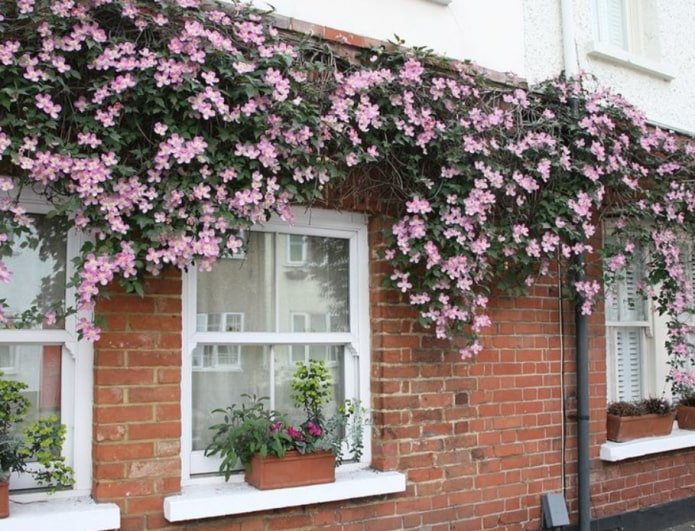
Unpretentious
Most clematis are demanding of growing conditions, especially if planted in a cool climate. They prefer a lot of light and warmth, fertile soil. However, among the huge variety of these plants, there are also very unpretentious varieties.
Representatives of this group include the young variety “Avangard” from the Viticella group, bred by British breeders in 2004. This is a medium-sized liana (up to 3 m high) with bright red-pink flowers about 5 cm in size. It actively grows and blooms both in full sun and in the shade, and tolerates moderately cold winters well. It only needs strong spring pruning and protective shelter.
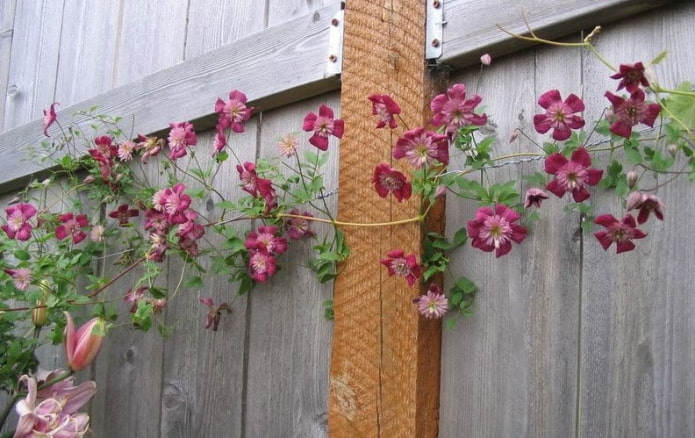
A striking representative of large-flowered unpretentious clematis is the variety “Anastasia Anisimova”, widely cultivated by Russian flower growers for more than 50 years. It was named in honor of the very employee of the State Nikitsky Botanical Garden. This is a medium-sized (1 to 2.5 m high) liana with smoky-blue flowers. It is planted in garden plots and balconies, decorates gazebos, where it blooms very beautifully. Requires minimal care. It is resistant to most fungal diseases.
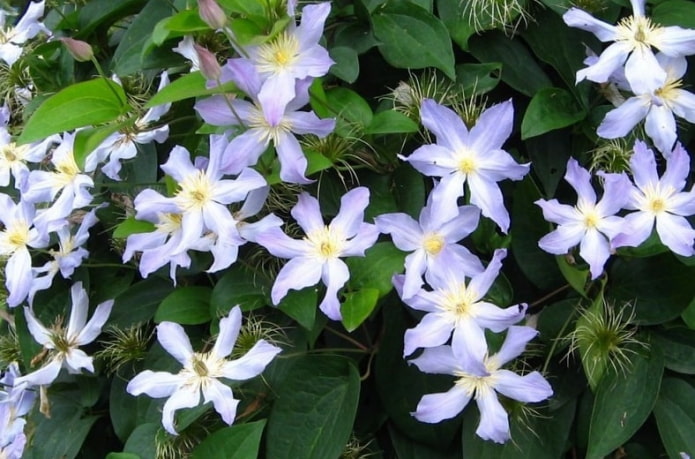
Frost-resistant
Although most varieties of clematis are grown in USDA zones 4-9, where hot sunny summers and warm winters reign, there are also cold-resistant varieties. They are usually divided into 3 categories.
Group I includes clematis intended for planting in USDA zone 3. These are predominantly hardy small-flowered plants, each of which blooms in early and late spring. A typical representative of Group I clematis is the ‘White Swan’ cultivar, 3-4 m tall, with double flowers of pure white and buttery yellow clusters of stamens.
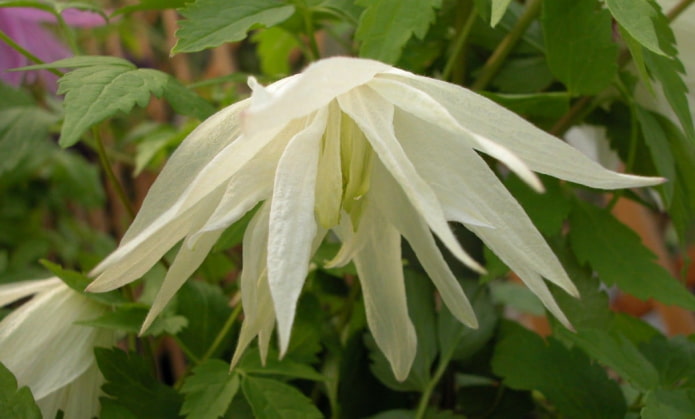
Group II includes profusely flowering clematis, the buds of which bloom in late spring and continue to form in waves (on young parts of the shoots) during the summer. As a rule, they are also grown within USDA zone 3 and higher, since they require warmth during the first flowering period. However, they can also be cultivated in colder climates, but in this case the buds are formed in early summer and only once per season. A typical representative of group II is the variety “Mnogosvetnyy siniy” (no more than 2 m high), the flowers of which are formed by dark blue petals and modified stamens (staminodes).
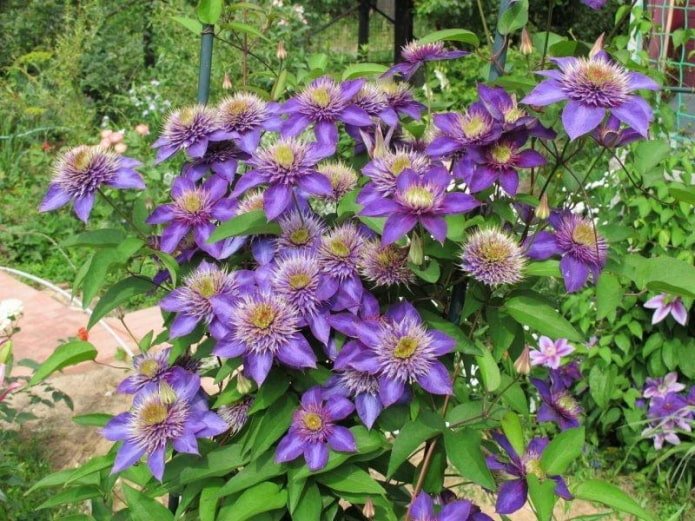
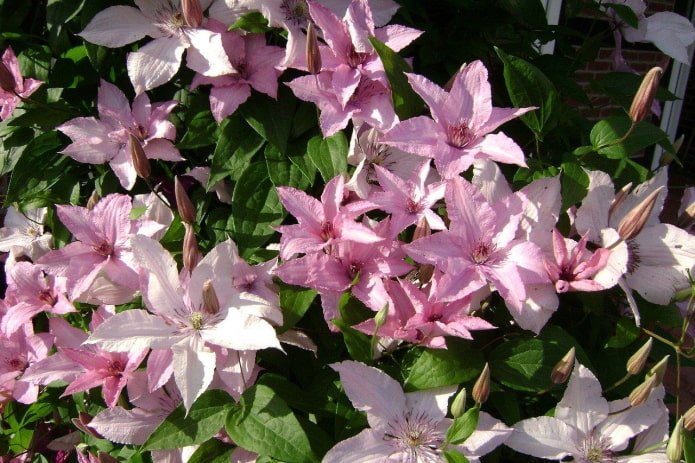
Clematis of group III bloom late: from mid-summer to early autumn. These are the most hardy and often unpretentious species. A good example of such plants is the fast-growing and undemanding variety Etoile Violette, about 4 m high, with elegant, medium-sized dark purple flowers (about 14-15 cm in diameter).
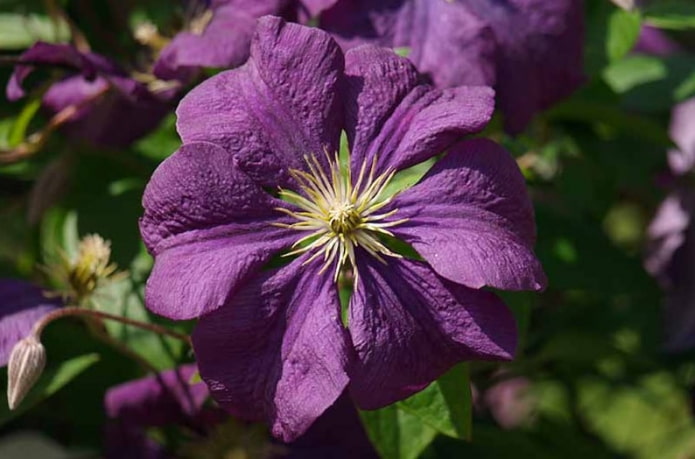
Climbing
According to the description, many varieties of clematis are climbing plants, among which there are both vigorous tall and compact species. They grow well in different climates, and the only common condition for their cultivation is to keep the roots in cool and well-moistened soil.
The largest (more than 4 m high) vines include the Montana variety, or mountain clematis with large single or clustered buds. Most of its subspecies have a height of 6 to 9 m and are widely used in modern landscape design.
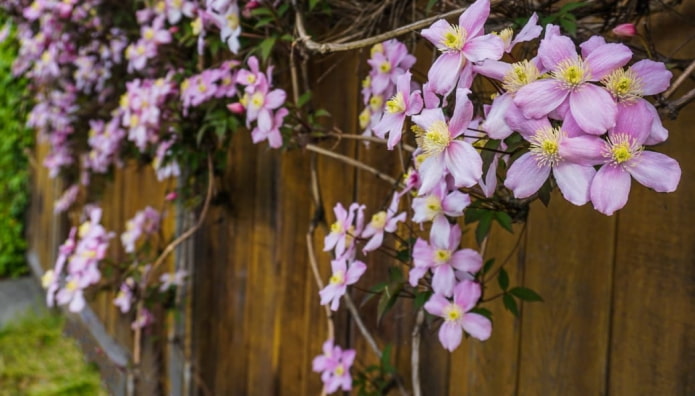
A medium-sized climbing vine is “Purpurea Plena Elegans”, with an average height of 3 m according to the botanical description, with double flowers.

A representative of low-growing herbaceous clematis is small-flowered variety “Ruguchi” with purple buds, in shape (usual description) like bells. This plant is from 1.8 to 2.4 m high. It is used in vertical gardening (when decorating gazebos and various fences), in container gardening.
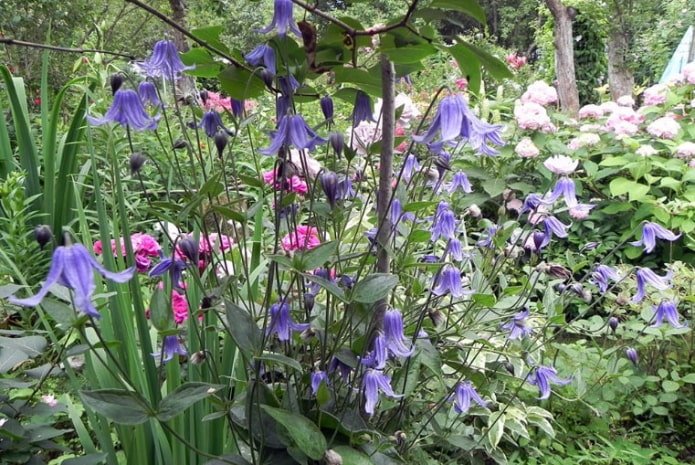
Early flowering
Many gardeners want clematis to bloom in the spring as early as possible. And they have a lot to choose from: the group of early flowering varieties is very extensive. You can choose them by description.
A popular representative of plants in this category is the groundcover variety “Willie” (2-3 m high) of Dutch origin and Prince Markhams Pink. Already in May, beautiful bell-shaped flowers of pink-lilac color with a darker shade at the base of the petals bloom on it. According to the description, it belongs to cold-resistant varieties and can overwinter without shelter in USDA zones 4-9.
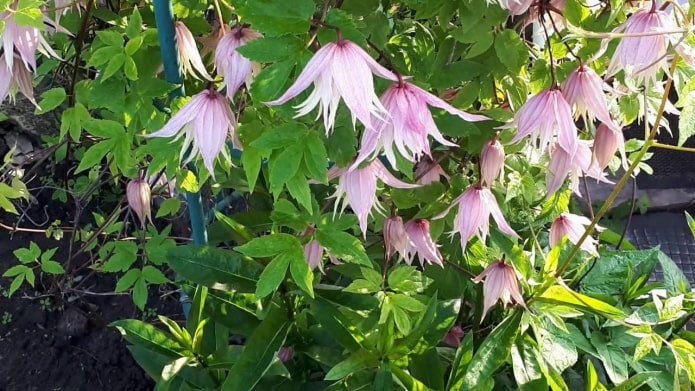
What colors are there?
Clematis form flowers and inflorescences of a wide variety of shades, including pure white, pink, red, blue and purple (description may vary). Many of them have a 2-color color.
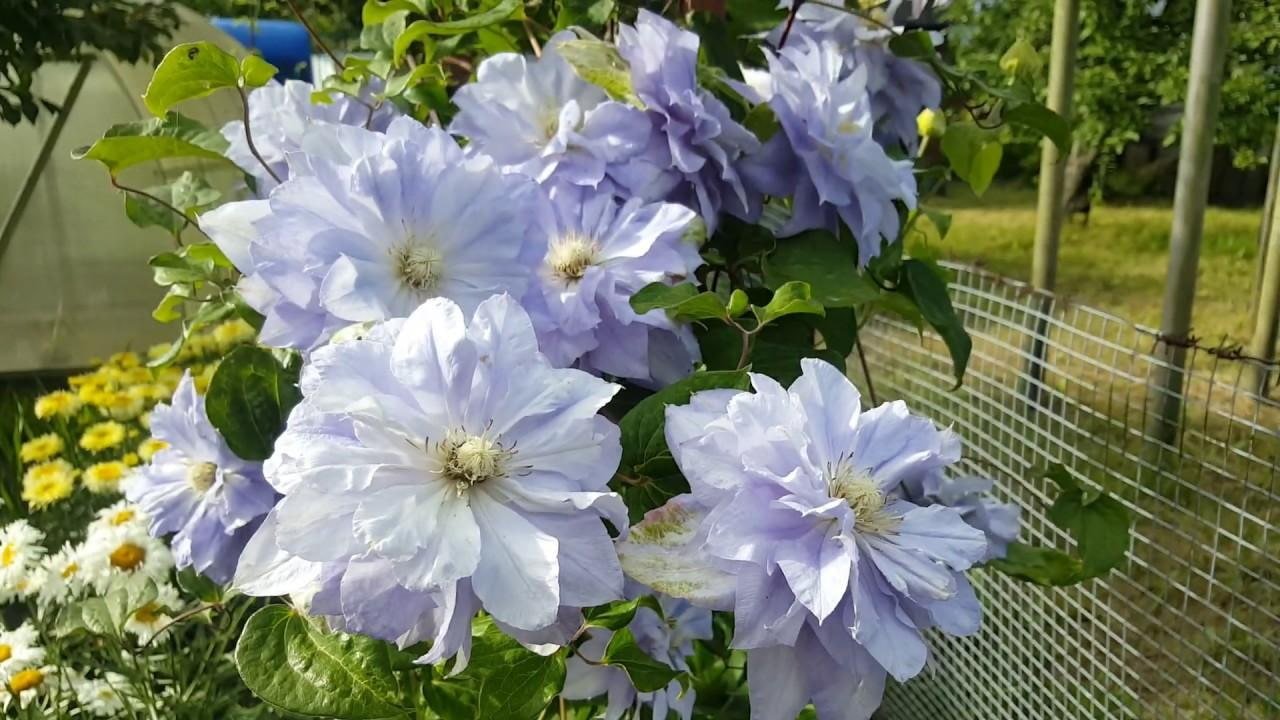

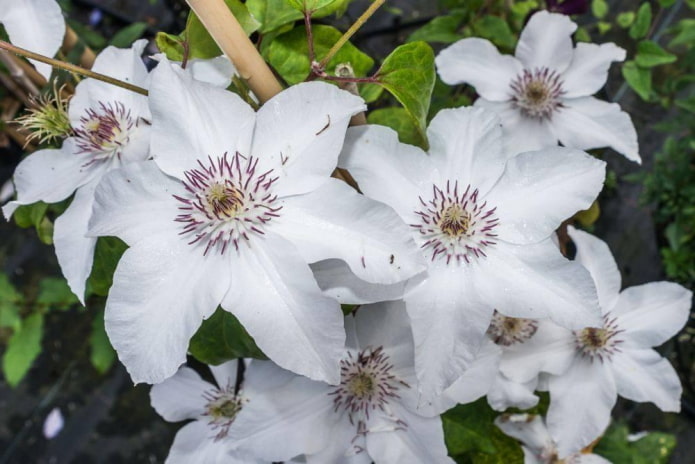
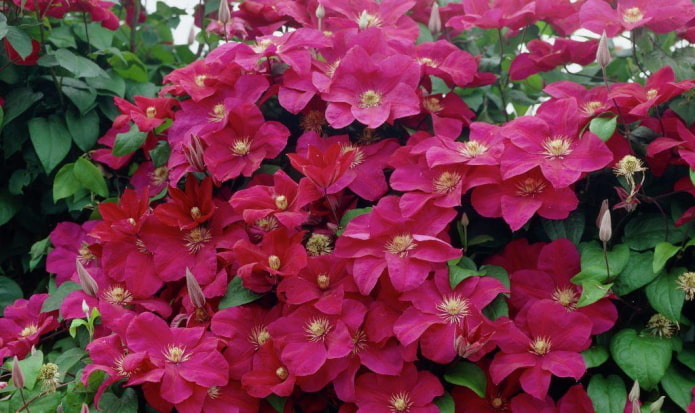
Popular Clematis Varieties
There are over 230 species of clematis and countless varieties. However, certain hybrids have become the most popular among Russian flower growers. The characteristics of each of them are given in the description below.
President
A deciduous liana from the Jackman group, about 2-3 m high, with large star-shaped flowers, the average size of which is about 15-17 cm. The petals are bright purple with a pinkish or reddish tint, dotted with the finest white “threads”. Young shoots of the liana cling to static supports with aerial roots and elegantly twine around them.
The plant blooms from late May to early September. This is one of the fastest growing varieties, which can add 10-15 cm in height per night. And its maximum height is 2.5 m.
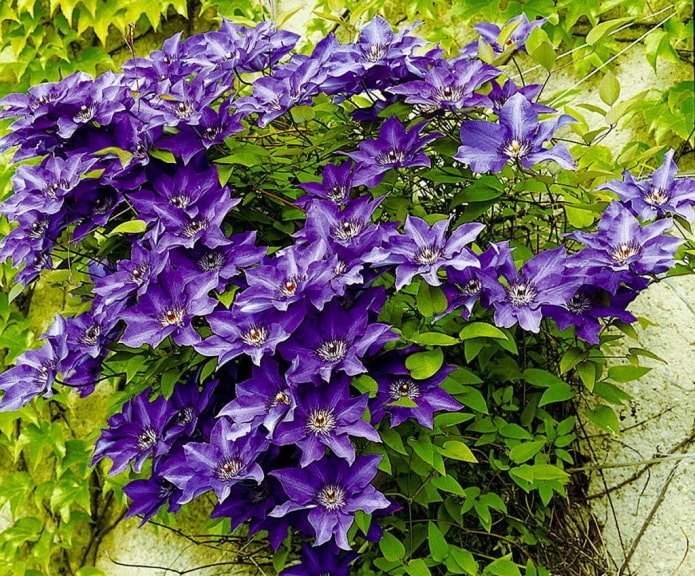
Diamond Ball
A large-flowered liana that effectively twines around vertical supports, living shrubs and trees. It has large spherical inflorescences about 10-12 cm in diameter, formed by white-blue flowers with delicate semi-double or double petals. It blooms in June and July, sometimes in August. Widely used in garden design.
Clematis Diamond Ball loves warmth and sunlight, but needs its roots to be cool. It tolerates winter well in USDA zones 4-9, but requires shelter for safety.
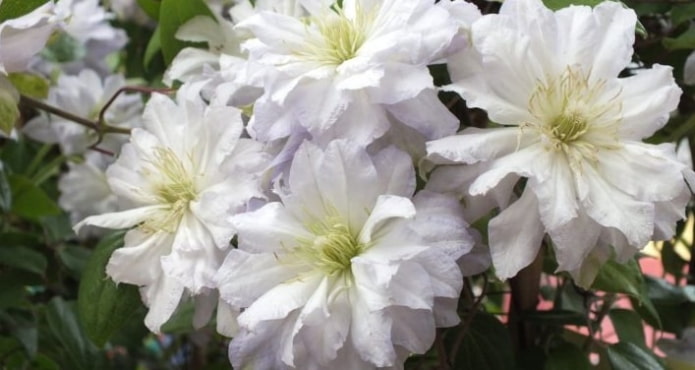
Piilu
One of the most common varieties, the popularity of which is due to its unpretentiousness and incredible beauty. The plant is a climbing liana with a stem height of 0.9 to 1.5 m. During the flowering season, clematis Piilu is covered with flowers (about 14 cm in diameter) with corrugated petals of a delicate purple color, along the center of which there is a wide bright pink stripe.
The plant blooms 2 times a year: in the first half of June and in early September. For active development, it requires a lot of sunlight and moderate watering, porous loose soil. It is widely used in landscaping garden plots.
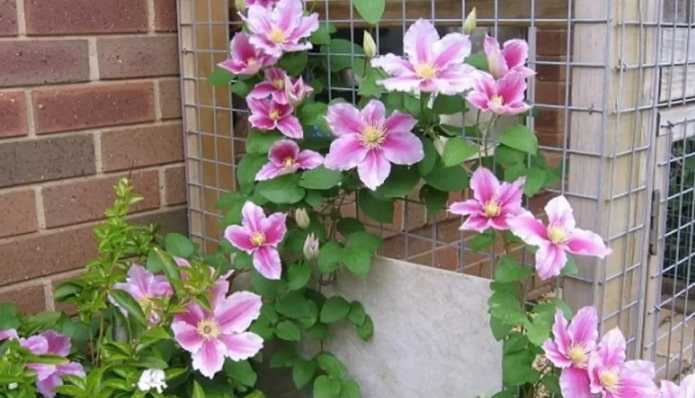
Red Star
A large-flowered clematis bred by Japanese breeders in 1995. This variety is rarely grown by flower growers, but it is very unpretentious in care and beautiful. The climbing shoot has a height (length) of about 1.5 m. It has many large bright leaves, and during the flowering period, large buds bloom on it. Double (on last year’s shoots) or simple (or semi-double) flowers (on new shoots) with petals of red shades are formed, along each of which there is a light pastel stripe. In the center are grouped yellow stamens with purple anthers. The buds exude a light aroma.
Clematis Red Star has found application in landscape design: it is used to create a hedge, the plant is often planted next to conifers or thickets of deciduous shrubs.
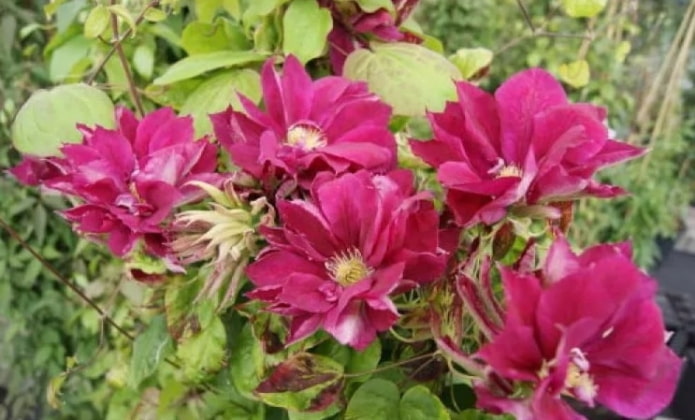
Stefan Franczak
One of the newest Polish varieties, bred in the private nursery of Szczepan Marczyński. Named in honor of the author’s close friend, the Jesuit monk Stefan Franczak. This is a beautiful plant up to 2 m tall with many light green simple leaves of medium length, with large flowers (about 8 cm in diameter) formed by corrugated blue petals.
Clematis Stefan Franczak is considered one of the best varieties suitable for growing outdoors in USDA zones 4-9 and indoors. It loves a lot of sunlight and heat, prefers very fertile soils. Blooming begins in late June.
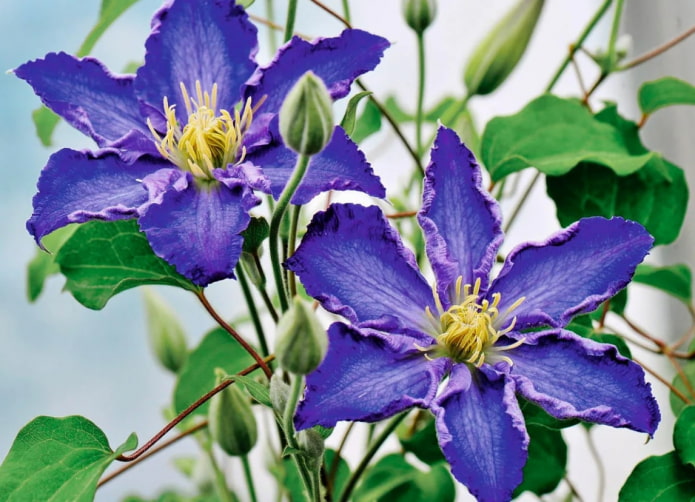
Jan Pawel II
This variety was created by the Polish breeder Stefan Franczak. It is considered the most popular in the world, which is due to its charming beauty and ease of cultivation. Clematis Jan Pawel II is a fast-growing liana from 2.5 to 3.5 m high, twining along natural supports and artificial structures. It has many trifoliate leaves with petioles of sufficient length, large flowers (up to 15 cm in diameter) of pure white color, which acquire a pinkish tint closer to autumn.
The plant is unpretentious: it tolerates temperatures down to -35°C (requires shelter) and needs only moderate watering. Protection from the wind is also necessary. In summer, only a few flowers bloom on the vine, but they look very impressive surrounded by thick, bright green foliage.
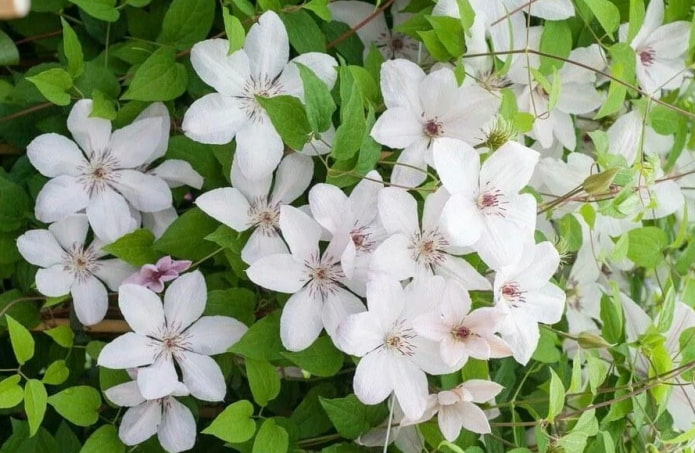
Henryi
It is one of the oldest large-flowered varieties, but thanks to its beauty it remains popular among gardeners. Its stems, 3-3.5 m high (long), grow quickly and hang down, covered with many trifoliate leaves. They produce many small silky flowers (up to 20 cm in diameter) of pure white color. The petals at the base acquire a contrasting shade: from purple to brown.
Clematis Henryi is unpretentious, but prefers places protected from the wind and slightly shaded. Blooming begins in June-August (with minimal pruning) or in August-September (with strong pruning).
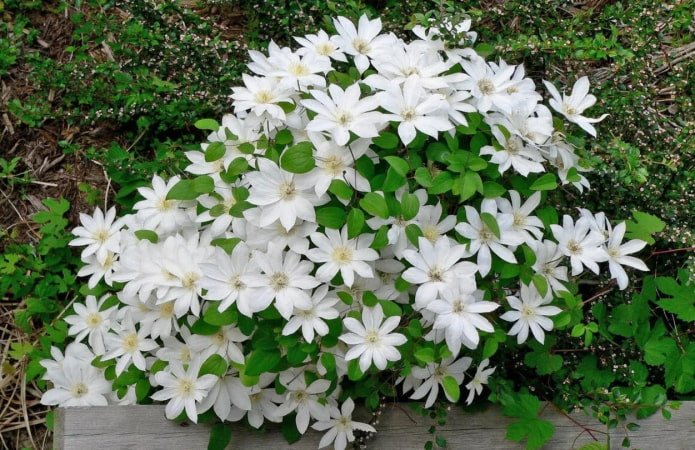
Rebecca
The plant is up to 2.5 m high (long) with many leaves (their length is 10-25 cm), with large bright red flowers (diameter from 13 to 18 cm), blooming in mid-May. They are characterized by abundant flowering. Their hue becomes more saturated, almost scarlet (as in the photo), if the clematis grows in full sun. When grown in the shade, the petals gradually turn purple.
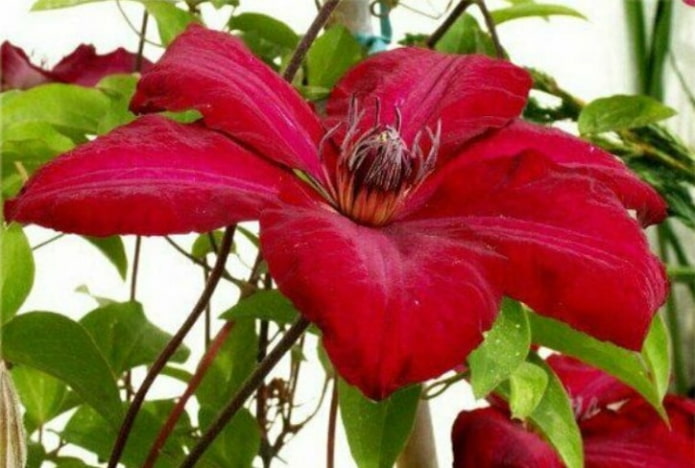
Josephine
A medium-sized (about 2.5 m high) clematis with many elliptical leaves, with large flowers (about 18 cm in diameter), formed by pink-scarlet double petals and tightly packed green sepals in the center (as in the photo). Its flowering period is short: the first buds bloom closer to the end of May and fade in a month. A variety for creating green fences.
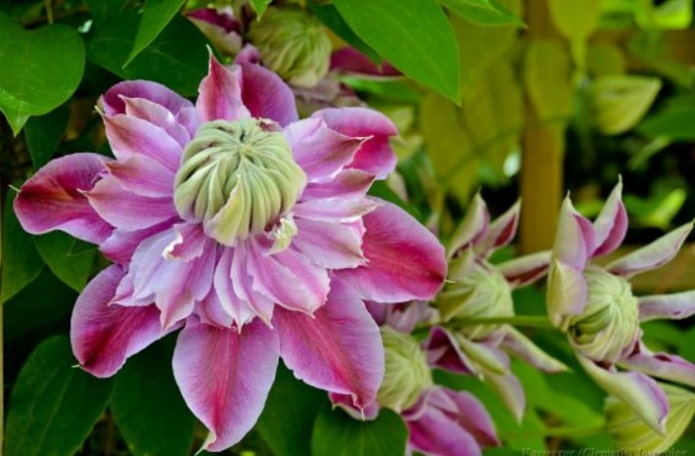
Andromeda
A large, fast-growing liana, the height of which can be 4 m. Many simple or trifoliate leaves appear on the stem. In May-June, lush snow-white flowers (up to 20 cm in diameter) bloom on it, with a contrasting crimson stripe running down the center of each petal (as in the photo). In the center, there is a cluster of yellow stamens, resembling a crown. Blooms in May and June.
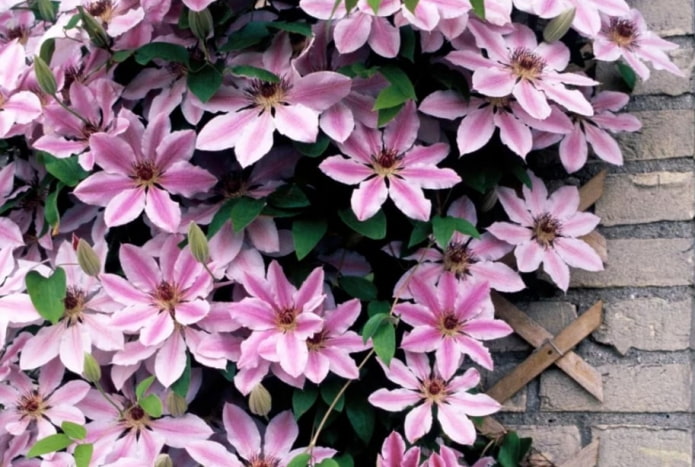
Elegy
A large, vigorously growing liana up to 3.5 m high (long), covered with numerous dark green, dense leaves. Blooms profusely and for a long time: in July, large violet-blue flowers bloom on the shoots and fall off only in October. Unpretentious in care, develops well in partial shade and tolerates cold. However, it requires careful soil preparation and regular fertilization.
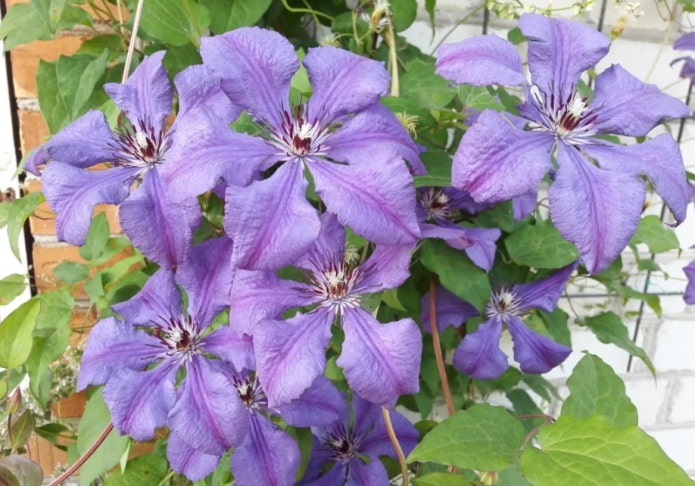
Ballerina
The variety was named after the Soviet ballerina Maya Plisetskaya: it is just as delicate and elegant. The plant is a perennial liana, strewn with many leaves. It forms a bush about 3 m high (long), on which large snow-white flowers (about 13 cm in diameter) bloom in early summer, sometimes with a greenish tint. A beautiful contrast is created by the dark cherry-colored stamens located in the center. Blooms intensively in early summer, and by the end of July the number of buds is greatly reduced.
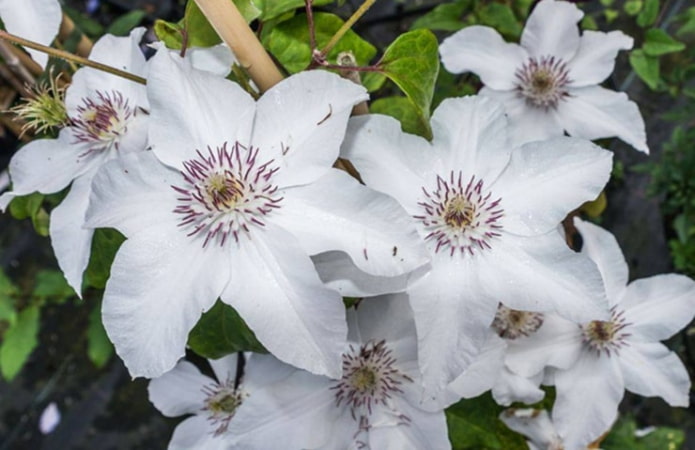
Mrs N. Thompson
Early flowering clematis with many obovate leaves, with large flowers (up to 20 cm in diameter) of an unusual color. The petals are a rich purple color, with a contrasting red stripe running down the center of each (as in the photo). Purple anthers adorn the pink stamens. This plant grows well in cold climates.
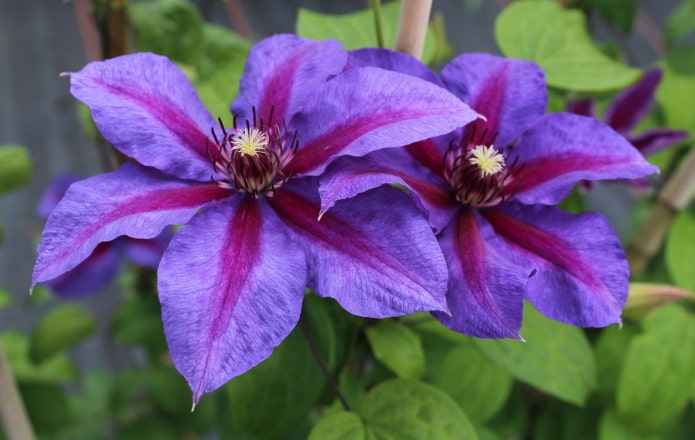
Honora
A typical representative of late-flowering clematis. It has a powerful shoot (with many leaves) up to 3 m high, which grows quickly. Large purple flowers (maximum diameter 16 cm) bloom on it in early June. The richly colored petals look good against the background of light bushes (as in the photo). In order for them to retain their unusual attractive shade, the plant should be planted in a shaded place protected from the wind. In the sun, the petals quickly fade.
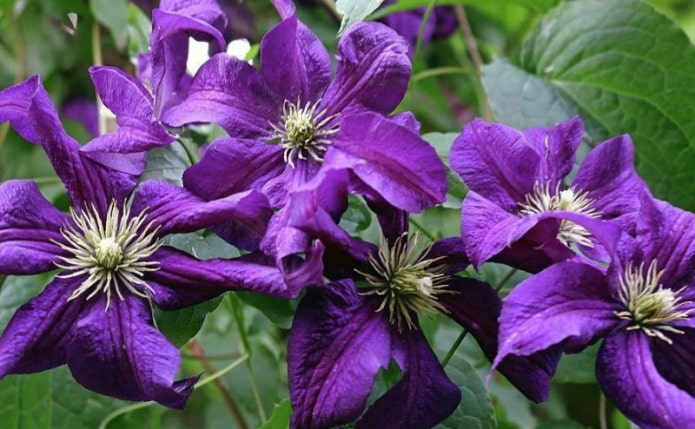
Romantika
A selective variety of Estonian origin, bred for cold regions of the temperate zone. Characterized by excellent winter hardiness and unpretentious in care. This variety of clematis is widely used in landscape design: with its help, fences and other pores are decorated. The stems are covered with many leaves of medium length. Large flowers of a rich purple color allow you to effectively place accents when decorating garden plots (example in the photo). The advantage is a long flowering period from July to September.
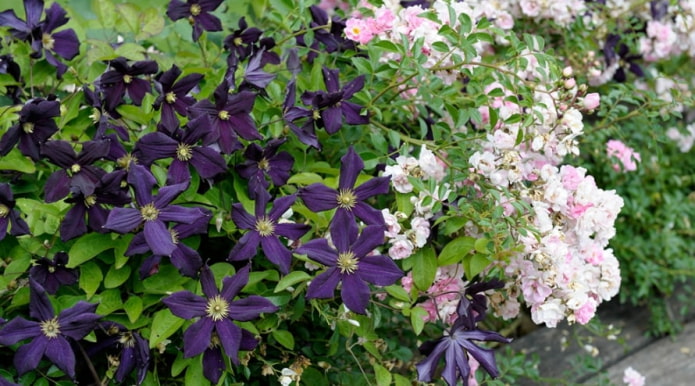
Now reading:
- Linoleum for the kitchen: 50 inspiring photos and design ideas in bright and dark shades.
- Combining colors for kitchen interior: recommendations, tables and diagrams
- Kitchen design in a Khrushchevka: 96 photos for inspiration from renovation to style
- Hidden kitchens in the interior: pros, cons and 35 photo examples.
- Installing roller blinds on plastic windows and walls: 4 simple steps.